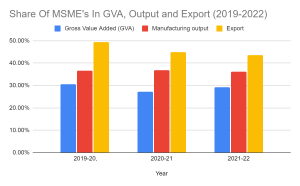Subject: GS-3 Indian Economy
Context:
- MSMEs are the backbone of the Indian economy, but they need support to succeed in exporting. Reforms and e-commerce can help MSMEs overcome challenges and achieve export success.
Role of MSME Sector In Indian Economy:
- The share of MSME Gross Value Added (GVA) in India’s Gross Domestic Product (GDP) has displayed a fluctuating trend over the last three years (Refer-Graph).
- However, the share of MSME manufacturing output in the overall Indian manufacturing output remained relatively stable (Refer-Graph).
| Classification |
Micro |
Small |
Medium |
| Investment in Plant and Machinery or Equipment |
Not more than Rs.1 crore. |
Not more than Rs.10 crore. |
Not more than Rs.50 crores |
| Annual Turnover |
Not more than Rs. 5 crores. |
Not more than Rs. 50 crores. |
not more than Rs. 250 crores. |
- The share of MSME products in India’s total exports experienced a decline over the past three years. While in the fiscal year 2019-20, they constituted 49.4% of India’s exports, the share decreased to 45.0% in 2020-21 and further to 43.6% in 2021-22.

- Today, India’s share in global merchandise exports is around 2 percent, and less than 1 percent of MSMEs are exporters.
- The MSME sector has been a significant source of employment in India providing 110 million jobs. (Udyam Registration Portal).
Challenges for MSMEs in Exporting:
- MSMEs and the Global Market:
-
-
- India’s domestic market accounts for only about 2 percent of the global market size for these industries.
- However, to address the global market, India must aim for at least a 10 percent share of the global trade.
- Integration with ‘E-commerce’ platforms for MSMEs
-
- The rise of e-commerce platforms means MSMEs can now compete in the global arena.
- However, India’s current e-commerce exports stand at a modest $2 billion, a mere 0.5 percent of our merchandise exports.
- Small Scale (Dwarfism) of MSMEs:
- It is nearly impossible for a typical small business to first find customers abroad, and then navigate the logistical, financial and compliance complexities of the export sector.
- However, 85 percent of MSMEs are classified as “dwarfs” — older than 10 years but still smaller than 100 employees.
Way Forward for MSMEs:
- E-commerce platforms can match small businesses with customers, and handle logistics and even compliance.
- Create a “green channel” for e-commerce exports to expedite Customs clearance. This will help MSMEs to get their products to market faster.
- Allow “exporter” and “product owner” to be separate entities. This will let aggregators work much more easily with small enterprises.
- Streamline the rules of financial regulation for exports. Reduce the burden on MSMEs and give them the flexibility to price their products dynamically.
- Implement a one-stop trade portal that brings together all information and processes related to exporting, and places it into a single, streamlined workflow. This will make it easier for MSMEs to comply with all government regulations.
Source: Business Standard
![]() 19 Sep 2023
19 Sep 2023

